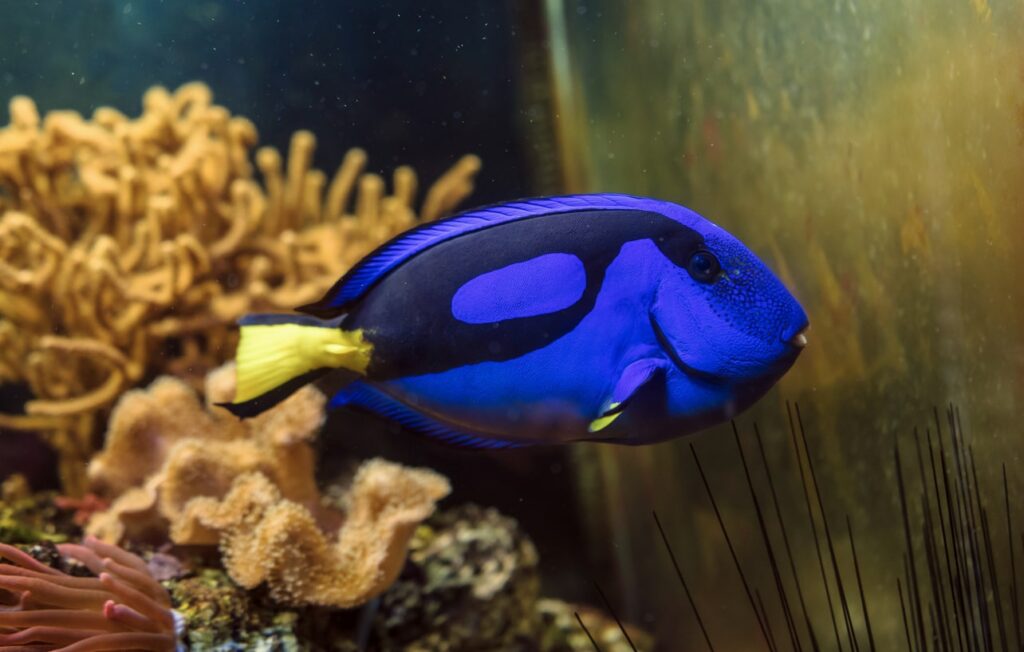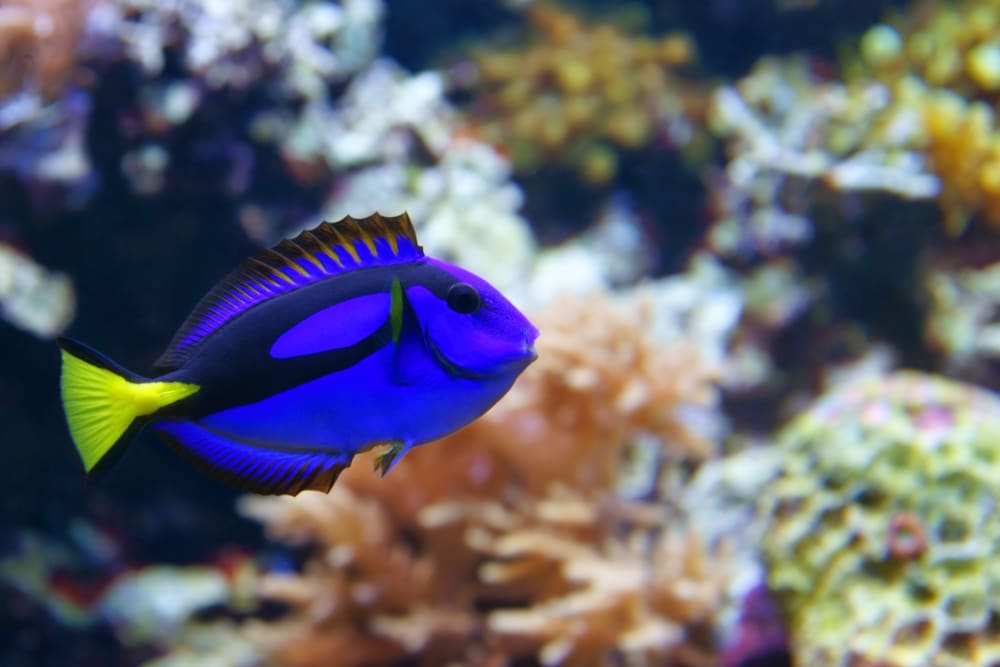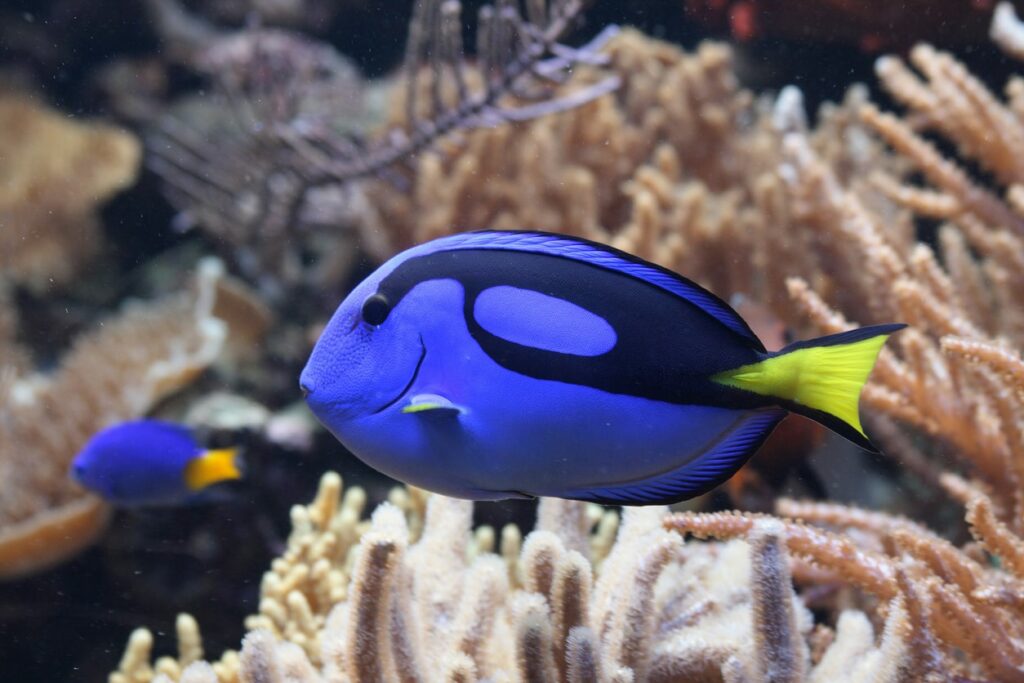Blue Tang fish are one of the top five most popular aquarium fish in the hobby. They are a gorgeous blue that we associate with the ocean deep, with an attractive yellow patch, shapely body, and are active, lively fish.

They aren’t exactly beginner friendly, but with the right knowledge, you can better your chances of succeeding with your first Tang. If you’re interested in keeping your very own Dory, then you should take a look at this Blue Hippo Tang care guide before you pick one up from the store!
What is a Blue Tang?
Blue Tangs have always been popular aquarium fish. But with the release of the movie Finding Nemo the demand for this fish soared as Dory became a household name and a present for every eager kid’s birthday alongside a Nemo.
This is an unfortunate state of affairs for the sensitive Blue Tang because they really aren’t beginner level fish. They are sensitive to sudden fluctuations in water quality, shy in temperament, and have very specific dietary needs that must be met. When not fed properly they are prone to developing a disease called Hole in the Head syndrome where pits form in the skin and flesh in their face and along the lateral line. Fortunately, there are ways to prevent this, which we will get to below!
Blue Tangs are also large, highly active fish as adults, regularly reaching 10-12 inches if they live beyond their first couple of years. They need aquariums between 150-180 gallons in size, at a minimum, with plenty of space and a strong current for them to swim against.
More About The Surgeonfish Family
Tangs are also known as Surgeonfish due to the extremely sharp retractable spine they have on both sides of their tail. Normally, it lies flat, like a jackknife blade. But when threatened or feeling aggressive, they can push it outwards to slap against the flanks of an enemy.
This spine is no joke; it’s razor-sharp and possibly venomous. The poison isn’t fatal or even dangerous to humans but the spine can open a profusely bleeding wound that’s ripe for infection.
Even a small Tang can break the skin so be careful when moving them in a net. Also, be careful when bagging them and taking your Tang home because the spine can easily slice the side of a bag open if forced against the fish.
While they have some negatives to consider they are still stunning aquarium fish that are reasonably hardy in the right conditions. So what does it take to keep a Blue Tang happy and healthy?
- Common Names: Hippo Tang, Blue Tang, Regal Blue Tang, Dory Fish, Pacific Regal Blue Tang
- Scientific Name: Paracanthurus hepatus
- Origin: Indo-Pacific Ocean
- Length: Up to 12 inches
- Aquarium Size: 150+ gallons
- Temperament: Peaceful
- Ease of Care: Moderate

Caring for Blue Hippo Tangs
Blue Hippo Tang, Pacific Regal Blue Tang, Blue Tang. Regardless of the name you choose, these fish are excellent show specimens once settled into the right aquarium!
Blue Hippo Tang Aquarium Size
Aquarium size is extremely important for Blue Tangs because they are very large, active fish that need optimal water quality. Unfortunately, 90% of the aquarists who buy a “Dory” can’t provide for them long-term.
Within 4 to 5 years of age, your Blue Tang will be 7-8 inches long. Fish this big need between 75-100 gallons of space. And as fully grown adults a Blue Hippo Tang needs a 150-180 gallon tank. Larger tanks are important because these are big, fast-swimming fish that are often very skittish.
Even as juveniles they are prone to dashing about when frightened and need space to avoid crashing into decorations. A larger aquarium also gives you a decent shot at keeping more than one if you really like Blue Tangs. They are one of the least aggressive Tangs. But they are still fairly aggressive towards their own kind when the tank is too small.
When aquascaping for your Blue Tang you’ll want to make sure there are a few hiding spots available. Ones that are unclaimed by other cavity-dwelling fish like Royal Grammas or Engineer Gobies.
When startled a Royal Blue Tang will dash to the nearest cave or even a simple crack between some rocks. Otherwise, they spend most of their time exploring regions of the tank, looking for plankton and algae.
Water Conditions
Oxygenation is extremely important to Blue Tangs. In nature, they live in regions where the currents are strong and oxygen is continually being churned into the water. Blue Tangs love to swim against a strong current and the aquarium should never be low in oxygen for them.
Powerheads, current generators, wavemakers, and other sources of flow are essential to good Blue Tangs. If your other fish are sensitive to flow, then at least add some aeration to ensure oxygen levels remain high. Position the outflow of your filter so that bubbles are driven into the water. You can also use a filter spray bar to increase the surface area of the zone being agitated and oxygenated.
Blue Tangs are on the delicate side and aren’t tolerant of elevated levels of ammonia, nitrite, and nitrate. This makes them poor fish to add to a new reef tank first, as New Tank Syndrome will likely kill them.
New tank syndrome occurs when ammonia levels rise as the biological filtration system stops keeping up with fish waste. And when one fish dies, it causes a second ammonia spike, which kills the others. Only add Blue Tangs to aquariums that are 3-6 months old and mature enough not to suffer from this cycle.
In other respects, Blue Regal Tangs are similar to most other saltwater fish. They prefer a pH of 8.0-8.4, which is easily achieved through a crushed aragonite substrate buffering the water chemistry. The specific gravity (salinity) should remain in the standard marine range and temperatures can be between 72-78℉.
Stability is the key to long-term Blue Tang health. This is why they tend to thrive in mature reef aquariums – SPS and LPS corals thrive in the same conditions.
Blue Tang Water Conditions:
- pH: 8.0-8.4
- Specific Gravity: 1.023-1.025
- Temperature: 72-78℉
- Current: Stong
- Tank Region: All
Tank Mates for Blue Tangs

Blue Tangs are shy, peaceful community fish that will ignore any other fish that isn’t a Tang. And when kept alongside other Tangs they are one of the most likely to be bullied.
Blue Tangs are model community tank residents for larger fish-only tanks. They are also mostly planktivores and therefore not a threat even to smaller fish like Gobies, Firefish, and small Damselfish. That said, small fish are likely to still feel threatened by the Tang’s size and speed for a while.
They also do well alongside predators that are peaceful towards anything they can’t eat, including Groupers, Marine Bettas, and Lionfish. The only real problem fish are aggressive and territorial types. Larger Angelfish, Dottybacks, Triggerfish, and certain large Damselfish (Maroon Clownfish, 3-Stripe Damselfish, etc) tend to be aggressive towards any other fish in the tank and will severely stress a Blue Tang.
Blue Tangs are also invertebrate and coral reef-safe as they will ignore all soft and hard corals, zoanthids, and sponges. You can also keep them with shrimp, crabs, Feather Duster worms, and snails. In fact, they are ideal coral reef fish because they not only need stability but will eat Macroalgae. Macroalgae is a huge problem in reef aquarists because it can cover up corals if it grows out of control. Blue Tangs don’t eat as much as exclusively vegetarian Tangs, but they will eat enough to keep it under control.
Keeping Multiple Tangs Together
One question that inevitably comes up when keeping these stunning fish is how to care for multiple Tangs. Keeping both multiple Blue Tangs and Blue Tangs with other Tangs and Surgeonfish is an expert-level challenge because these fish are extremely aggressive towards one another.
Paradoxically, many Tangs, including Blue Tangs, form schools or harems in the wild. So they have it in them to be intensely social. But the problem is that the ocean provides an infinite amount of space for them to figure out their own hierarchy. If one fish is being bullied it will eventually leave and join a new group, which they obviously can’t do in an aquarium.
Unfortunately, even keeping Tangs of different species can be a challenge due to the unique ecological niche Tangs have. As algae grazers, they can’t afford to share real estate with competitors because their food source grows slowly and they need to graze constantly. So they viciously attack other Tangs to secure good feeding grounds.
A dominant Tang may bite and slice at a subordinate Tang with its caudal spine until it dies, trying to get it to leave its turf. Blue Tangs are on the milder end of the Tang spectrum but may still fight to the death, especially in a smaller aquarium. Still, there are a few tricks you can try to increase your chances of success.
How to Prevent Regal Tang Fights
One way to get multiple Blue Tangs to live together semi-peacefully is to add them all at the same time as juveniles. As youngsters, they are much less aggressive. And as they sexually mature they will usually work out their own pecking order with not too much blood spilled. It goes without saying that you should be keeping them in a large tank for this to work.
If you want to keep multiple species of Tang your best bet is to choose Tangs that are of a different genus and look extremely different. For example, choosing a Zebrasoma species like the Yellow Tang to live with a Hippo Tang (Paracanthurus). A Kole Tang (Ctenochaetus strigosus), and a Naso Tang (Naso lituratus) will likely work well in a large tank. Especially if you raise them together while young. When mixing adults your best bet is to add the most peaceful species first, in this case, the Hippo Tang.
Feeding Blue Tangs
Feeding your Hippo Tang is just as important as aquarium size and tank mates. Hippo Tangs are true omnivores in that they eat both animal and plant matter. In this case, they get around 80% of their nutrition from zooplankton and the rest from grazing on macroalgae.
They should therefore be given a vitamin enriched blend of brine or mysis shrimp as a dietary mainstay alongside strips of nori and other sources of macroalgae. If you raise your own brine shrimp, feeding them on green water algae (gut loading) passes on the nutrition they consume to their predator (the Blue Tang).
Since it’s hard to provide the diversity of small organisms Hippo Tangs need to avoid vitamin deficiencies, you should soak their brine and mysis shrimp in a vitamin formula to boost their nutritional content. Tangs of all kinds are especially prone to vitamin deficiencies, which will result in hole in the head disease if fed standard marine flakes and pellets for too long.
This degenerative disorder of Blue Surgeonfish is extremely unsightly and ultimately fatal. But it can be quite quickly reversed once you realize the cause and attend to both food and water quality! You can also offer them lightly boiled terrestrial vegetables like zucchini, cucumber, and spinach alongside their nori flakes. But unlike other Tangs they are more on the carnivorous side, so don’t skimp on the shrimp!
Consider also raising macroalgae in a refugium for a constant supply of nutrient-rich, high-quality marine algae. Refugiums are the biological equivalent of a protein skimmer, acting as a living filter that exports phosphorus, nitrogen, and other elements that cause problems for water quality.
Breeding Adult Blue Tangs
Breeding Hippo Tangs in captivity is almost unheard of and extremely difficult due to their need for space and their aggressive social dynamics. In the wild, males and females form pairs that exist alongside the school.
When ready to spawn, Hippo Tang pairs will break away from their harem or school to lay large quantities of eggs directly into the water column (pelagic broadcast spawning). The eggs contain oil, which makes them buoyant. There they float along with the plankton soup until they hatch and the larvae compete to eat or be eaten among the plankton.
Blue Surgeonfish have occasionally spawned in public aquariums where tank sizes are thousands or even hundreds of thousands of gallons in size. But they almost never spawn in home aquariums.
In Conclusion
Blue Tang care is a little more involved than easier marine fish like Clownfish. But so long as you are ready to provide them with the space and nutrition they need, a Regal Blue Tang is a solid choice for intermediate-level aquarists.
Frequently Asked Questions about Blue Tang Fish
Interested in learning more about the Pacific Blue Tang? Then here are a few frequently asked questions worth reading.
Are Blue Tang Fish Poisonous?
Pacific Blue Tang fish are not poisonous – poison is something that you eat. As far as we know, if you want to eat your Regal Tang, you can. But they are venomous – the caudal peduncle spine is capable of effortlessly slicing through skin. And a mild venom will cause the wound to sting painfully. It is not nearly enough to send you to the hospital but it isn’t fun, either.
Can You Keep a Blue Tang Fish As a Pet?
These beautiful fish make great pets as long as you can give them the water quality and varied diet they need. That means lots of algae, plankton, and other fresh seafood. When they are not fed well and kept in poor water conditions Pacific Blue Tangs don’t do well. They quickly develop diseases like marine ich and hole in the head and eventually die.
Are Blue Tangs Good For Beginners?
Ever since the movie Finding Nemo came out, everyone wants to try keeping a Royal Blue “Dory fish.” But Royal Blue Tangs are not very easy to keep. Like other surgeonfish, they are a little sensitive to poor water conditions.
How Big Does a Blue Tang Get?
Pacific Blue Tangs will grow to be 10-12 inches long once fully grown. They are also deep-bodied and very active fish. So 150 gallons is an absolute minimum aquarium size for one.

